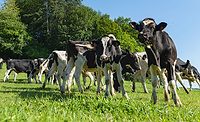U.S. Sales of Medically Important Antibiotics for Use in Food-Producing Animals Dropping Since 2015

Credit: Jo-Anne McArthur (weanimalsmedia) via Unsplash
Sales and distribution of medically important antimicrobials approved for use in food-producing animals has been decreasing since 2015, but with only a slight reduction seen in 2020–2021, according to a recent report from the U.S. Food and Drug Administration’s Center for Veterinary Medicine (FDA’s CVM).
The practice of using antibiotics to fight disease or promote growth in food-producing animals is a contributing factor to the global threat of antimicrobial resistance (AMR). The World Health Organization (WHO) estimates that AMR will cost 10 million lives and $100 trillion dollars by 2050 if no proactive solutions are taken.
Sponsors of approved animal drug products containing an antimicrobial active ingredient are required to provide data to FDA on the volume of antibiotics that are distributed or sold for use in food-producing animals. Each year, FDA compiles the Summary Report on Antimicrobials Sold or Distributed for Use in Food-Producing Animals to make such data available to the public.
The 2021 report reveals that domestic sales and distribution of medically important antimicrobials approved for use in food-producing animals decreased by less than 1 percent from 2020–2021, versus a 38 percent decrease seen from 2015–2021. As the peak year for antibiotic sales for use in food-producing animals was 2015, there is less of a decrease seen for the years 2012–2021, at 33 percent.
More specifically, penicillin sales (10 percent of total sales volume) dropped by 19 percent from 2020–2021, while tetracycline sales (65 percent of total) reduced by 1 percent. Macrolide (9 percent of total) and lincosamide sales (3 percent of total) both increased by 1 percent, however. Other medically important antibiotics sold in 2021 for use in food-producing animals included sulfonamides (5 percent of total), aminoglycosides (6 percent of total), cephalosporins (less than 1 percent of total), and fluoroquinolones (less than 1 percent of total).
An estimated 41 percent of medically important antimicrobials sold were intended for use in cattle, 42 percent for swine, 11 percent for turkeys, 3 percent for chickens, and 3 percent for other or unknown species. Additionally, an approximate 79 percent of cephalosporins, 45 percent of sulfonamides, 52 percent of aminoglycocides, and 43 percent of tetracyclines were intended for use in cattle. About 89 percent of lincosamides and 41 percent of macrolides were intended for use in swine. An estimated 72 percent of penicillins were intended for use in turkeys.
In the report, FDA determined which antibiotics were “medically important” based on their utility for treating disease in humans. It is important to note that the sales data represent a summary of the volume of product sold or distributed through various outlets by the manufacturer intended for sale to the end user, not the volume of product ultimately purchased by the end user for administration to animals.
Looking for a reprint of this article?
From high-res PDFs to custom plaques, order your copy today!





